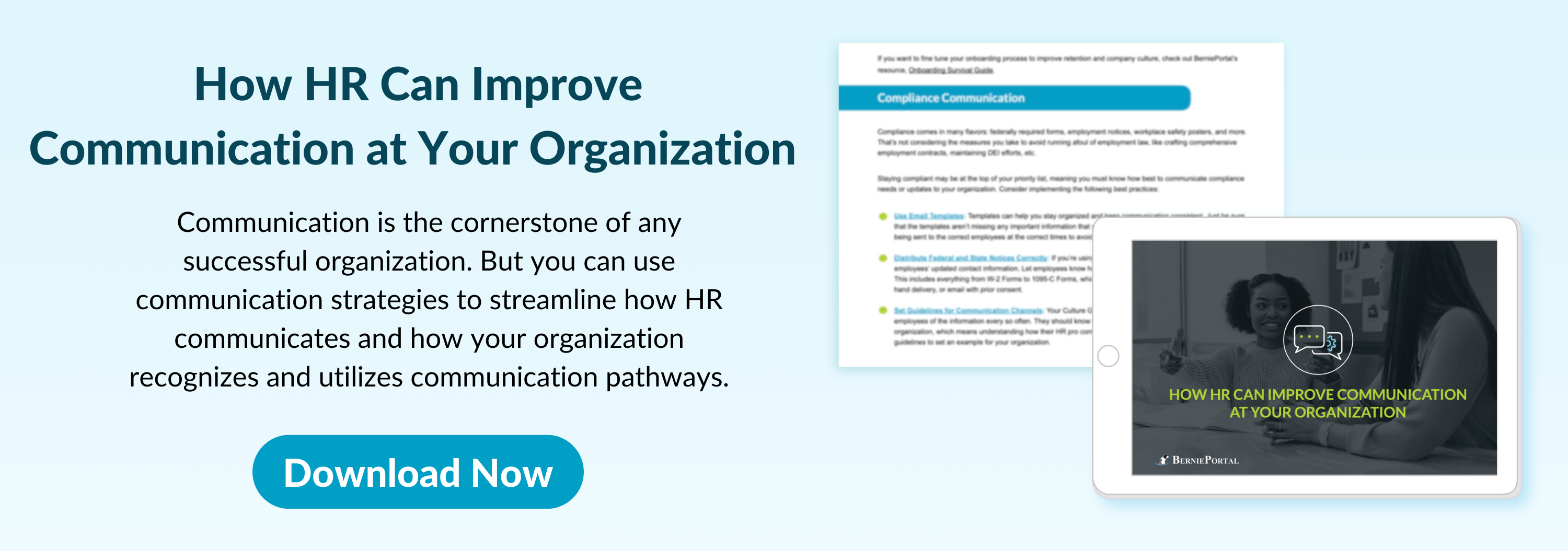Written by
Will Miranne
Will is an aPHR-certified writer on the marketing team at BerniePortal. He writes about healthcare, human resources, and benefits.
The State of Employee Burnout in 2023

Employee burnout is a concern many organizations are facing in the workforce today. Burned-out employees can dampen efforts to boost culture, retention, and even employee morale. The good news is that while numbers are still high, the number of burned-out employees is decreasing.
Read on to learn more about employee burnout, its current trajectory, as well as ways that you can work to eliminate it altogether.
What Is Employee Burnout?
Employee burnout is a state that involves feelings of physical, emotional, and mental exhaustion. It is typically caused by prolonged and excessive amounts of stress at work. It is a condition that can affect anyone, regardless of their industry, job title, or experience level.
Burnout typically arises when employees feel overwhelmed, overworked, and underappreciated, leading to a sense of hopelessness and disengagement from work.
Burnout symptoms can manifest in various ways—such as feelings of exhaustion and fatigue, decreased motivation, lack of focus, and irritability. Employees experiencing burnout may also have trouble sleeping, suffer from headaches and other physical symptoms, and withdraw from social interactions. Burnout can impact an employee's productivity, creativity, and ability to perform effectively, leading to decreased job satisfaction and even a desire to leave their current position.
Organizational factors such as high workload, lack of support, and insufficient resources can contribute to employee burnout. In addition, individual factors such as perfectionism, a strong work ethic, and difficulty setting boundaries can also increase the risk of burnout.
Employers can help prevent burnout by providing employees with resources and support, encouraging work-life balance, and fostering a positive work culture that values employee well-being. Addressing burnout is vital for the health and success of both employees and organizations.
Is Employee Burnout Improving?
According to a recent survey from Eagle Hill Consulting, employee burnout is on the decline but is still high. Approximately 46% of employees reported feelings of burnout, which is an improvement over the 49% in August of 2022.
This is a sign of a positive “bounce back” from the jump in numbers amid the pandemic, and it is likely that these numbers will gradually improve even further. However, the concern lies in the rate at which they improve. Nearly half of those surveyed are experiencing burnout, and while a few percentage points is a good thing, the numbers are still much higher than they should be. For this reason, organizations will need to crack down on strategies to combat these widely experienced feelings of burnout.
Many organizations have implemented strategies to prevent and address employee burnout, such as offering flexible work arrangements, promoting work-life balance, and providing mental health resources and support. COVID-19 also highlighted the importance of supporting employee well-being and mental health, which has led to increased attention on the issue.
But, despite these efforts, employee burnout remains an ongoing challenge in many industries and organizations. The high demands and pressure of certain jobs, such as healthcare or high-tech industries, can contribute to burnout, and there may still be a cultural expectation of overworking and prioritizing work over personal well-being in some workplaces.
Though progress has been made in addressing employee burnout, it is clear that more work needs to be done to create a work environment that prioritizes employee well-being and promotes a healthy work-life balance.
What Can Employers Do to Decrease Burnout?
Employers play a critical role in preventing and addressing employee burnout. By implementing strategies to support employee well-being and create a positive work environment, employers can help employees feel valued, engaged, and motivated.
Lolly Daskal, the best-selling author of "The Leadership Gap,'" and leadership executive coach, says:
"To avoid burnout, prioritize:
Rest and relaxation.
Boundaries and self-care.
Time management and prioritization."
This advice gets to the heart of the issue. Employees who are burned out need rest and self-reflection to identify the concerns plaguing them and causing feelings of burnout.
One key step employers can take to eliminate employee burnout is to encourage work-life balance. This may encourage employees to take PTO or time for a vacation. Flexible work arrangements are another way employers can promote positive working conditions.
Another strategy is to provide employees with the resources and support they need to succeed. This might mean providing employees with training and professional development opportunities to hone and develop their skills. Employers can also provide specialized tools and resources to help employees manage their workload and prioritize tasks more effectively.
Employers can also create a positive work culture that values employee well-being. This can involve promoting open communication, encouraging employee feedback, and recognizing employee achievements through systems such as gamification. Employers can also foster a sense of community and teamwork by encouraging team-building activities and promoting social connections between employees.
Finally, employers can address burnout by identifying and addressing the root causes of stress in the workplace. This can involve conducting surveys or focus groups to gather employee feedback, identifying high-stress areas of work, and implementing changes to reduce stressors. Employers can also provide mental health resources and support, such as counseling or access to employee assistance programs.
Additional Resources
You can also stay informed, educated, and up-to-date with all things HR by using BerniePortal’s comprehensive resources:
- BernieU—free online HR courses, approved for SHRM and HRCI recertification credit
- BerniePortal Blog—a one-stop-shop for HR industry news
- HR Glossary—featuring the most common HR terms, acronyms, and compliance
- HR Guides—essential pillars covering an extensive list of comprehensive HR topics
- HR Party of One—our popular YouTube series and podcast, covering emerging HR trends and enduring HR topics
Written by
Will Miranne
Will is an aPHR-certified writer on the marketing team at BerniePortal. He writes about healthcare, human resources, and benefits.
Related Posts
Company surveillance tools have grown increasingly common in the last several years. Data...
In the current competitive job market, companies that are able to attract and retain top...
Recent years saw a rapid increase in workplace perk offerings. The goal was to entice...
Layoffs can be a difficult time for any organization and can leave the remaining...








Submit a Comment